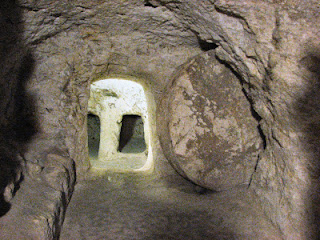Gehenna was not a continual burning fire in the Hinnom Valley
The word Gehenna is a Greek transliteration of the Hebrew
“Gei–Hinnom”, the “Valley of Hinnom” which defines Jerusalem’s western and
southern sides. Although the “constantly burning refuse” description is a favorite for
tour guides and pastors, Gehenna has nothing to do with a continual burning of
garbage in the Valley of Hinnom during the time of Jesus. This idea of
continual garbage burning appears first from a medieval Jewish commentator,
David Kimchi (ca. AD 1200), but it is wrong. Here is why:
According to the Bible the judgment on sin is death (Gen. 2:17, Rom. 6:23) and destruction (Matt. 7:13) and perishing (John 3:16). Death is the end of life and results in decomposition of human bodies by the worm, or if necessary in severe cases like war, by fire.
Rather than an eternal conscience torment in a disembodied soul in "hell", the lesson of Gehenna is a dishonorable fiery destruction and elimination.
1.
As mentioned above, there
is no evidence in contemporaneous Second Temple Period sources (the time of Jesus) of a refuse fire
constantly burning in the Hinnom Valley. The idea apparently originates from
Rabbi David Kimchi’s commentary on Psalm 27:13 which dates to over 1000 years
after Jesus (ca. AD 1200). Kimchi wrote: “Gehenna is a repugnant place, into
which filth and cadavers are thrown, and in which fires perpetually burn
in order to consume the filth and bones; on which account, by analogy, the
judgment of the wicked is called ‘Gehenna.’”
Note however, that even Kimchi’s quote relates predominately to fire used for the elimination of “cadavers…filth and bones”. That is, whatever fire Kimchi had in mind was for the destruction or elimination, not conscious torment, of the human corpse. For a Jew, respectful burial is a necessary and high honor. Disposal by fire is dishonorable. Kimchi is commenting on those who will not “see the goodness of the Lord in the land of the living” (Psalm 27:13) as opposed to those who will.
Note however, that even Kimchi’s quote relates predominately to fire used for the elimination of “cadavers…filth and bones”. That is, whatever fire Kimchi had in mind was for the destruction or elimination, not conscious torment, of the human corpse. For a Jew, respectful burial is a necessary and high honor. Disposal by fire is dishonorable. Kimchi is commenting on those who will not “see the goodness of the Lord in the land of the living” (Psalm 27:13) as opposed to those who will.
2.
There is no archaeological
evidence of a continually burning refuse fire from the 2nd Temple Period, or
any other period, in the Hinnom Valley.
3.
Garbage that burns is a
relatively recent phenomenon. One look in a modern trash can shows that our
garbage sure would make a nice fire as it is made up mostly of paper and
plastic. But it is almost all recent “junk”. Most garbage in the Second Temple
Period would not have the same flammable character: broken
pot shards, some food scraps, etc., and many of these items would be used
secondarily, e.g., food scraps for animal feed and flammable objects for controlled heating.
4.
Jerusalem receives an
average of more than 20 inches of rainfall a year, and it all comes in a period
of about four months (Dec-March). During these months the rain can come down in
sheets for days at a time. Nothing outside would keep burning.
5.
During the long dry summer,
if a fire started in the Hinnom Valley or anywhere else in the land of Israel,
people would immediately put it out, as there would be a danger of a spreading
brush fire. Southern California has a similar climate to Israel. Just as in
California, there is a reason fires are not left burning.
6.
The Hinnom Valley defines
the southern and western sides of the ancient city of Jerusalem. The prevailing
westerly winds would push any acrid smoke from such a fire right into the city.
These six reasons are enough to show that the “continual burning
in the Hinnom Valley” is an unlikely suggestion as to why the Valley of the Sons of Hinnom became associated with a destructive fire. See also here
and here for similar evidence.
The association of Gehenna as a perpetual conscious torment of “hell” is also misplaced.
The association of Gehenna as a perpetual conscious torment of “hell” is also misplaced.
We need to look no further than the Bible for why
Gai-Hinnom (Gehenna) came to be the example of how God will judge and
purge sin from the land with a relatively quick, but devastating, judgment.
The people of Israel were sacrificing their children by fire to a pagan god in
this valley. This activity is the epitome of how far man can stray from God.
God said – “I will destroy it…This sin will be stopped…I will make it a valley
of slaughter…and their dead bodies will be food for the birds of the air”
(Jeremiah 7:31-33, 19:4-7).
But carrion birds, wild animals and worms were sometimes not quick enough to remove decaying human bodies. In some cases, when the bodies were so many, fire would be used. One of the main reasons that corpses were burned in ancient Israel, usually those of the enemy, was to dispose of them following devastation in battle.
In Jeremiah's day, the people were making their children pass through fire (7:31). The Lord God said the judgment upon the people would include fire (Jer. 15:14, 21:12). In addition to the destruction of the city of Jerusalem by fire, many killed at the time would have been eliminated by fire rather than honorable burial.
But carrion birds, wild animals and worms were sometimes not quick enough to remove decaying human bodies. In some cases, when the bodies were so many, fire would be used. One of the main reasons that corpses were burned in ancient Israel, usually those of the enemy, was to dispose of them following devastation in battle.
In Jeremiah's day, the people were making their children pass through fire (7:31). The Lord God said the judgment upon the people would include fire (Jer. 15:14, 21:12). In addition to the destruction of the city of Jerusalem by fire, many killed at the time would have been eliminated by fire rather than honorable burial.
Another illustration of a multitude of corpses which required removal by burning comes from the book
of Isaiah 66:24 where following the devastation of
the Assyrian troops of Sennecharib around 700 BC by the messenger of Yahweh: "behold, they were all dead corpses"(Isa. 37:36). Enemy corpses could be so many that they had to be eliminated by fire instead of by burial or by carrion animals.
The decimation of the Assyrian army by a relatively quick judgment of warfare or plague from Yahweh left multiple dead bodies that, already starting to decompose, required disposal by fire. The prophet Isaiah said concerning the dead who had been enemies of Yahweh: “their worm does not die and their fire is not quenched”. The worm and fire may persist, but the person is consumed, gone. Isaiah had the perfect object lesson for Yahweh's enemies, including some from Judah. Don’t rebel against Yahweh. You’ll end up like them!
The decimation of the Assyrian army by a relatively quick judgment of warfare or plague from Yahweh left multiple dead bodies that, already starting to decompose, required disposal by fire. The prophet Isaiah said concerning the dead who had been enemies of Yahweh: “their worm does not die and their fire is not quenched”. The worm and fire may persist, but the person is consumed, gone. Isaiah had the perfect object lesson for Yahweh's enemies, including some from Judah. Don’t rebel against Yahweh. You’ll end up like them!
According to the Bible the judgment on sin is death (Gen. 2:17, Rom. 6:23) and destruction (Matt. 7:13) and perishing (John 3:16). Death is the end of life and results in decomposition of human bodies by the worm, or if necessary in severe cases like war, by fire.
Rather than an eternal conscience torment in a disembodied soul in "hell", the lesson of Gehenna is a dishonorable fiery destruction and elimination.


Comments
One can't help but see some connection in the prophets' minds. I wish we had a bit more to go on as to what the word really means. Dan. 12:2 does have the parallel חֲרָפ֖וֹת. If you are familiar with the word used anywhere else in Jewish literature, even in verbal form, I'd be interested to know.
It looks to me that, especially in Isa. 66:24, the "shame, contempt, abhorrence" is something that others look upon and perceive of those not receiving life. That is, for a person to experience perishing and then shameful disposal by burning, worms, wild birds or animals - others looking upon the spectacle are abhorred by it. (??)
That word "חֲרָפ֖וֹת" is simply the plural of the word חרפה (shame/contempt)- used until today in modern Hebrew in the express "בושה וחרפה"= "What a disgrace!"
The word appears in many places, such as in Genesis 34:14 "We cannot do this thing, to give our sister to one that is uncircumcised; for that were a reproach unto us" (reproach= חרפה)